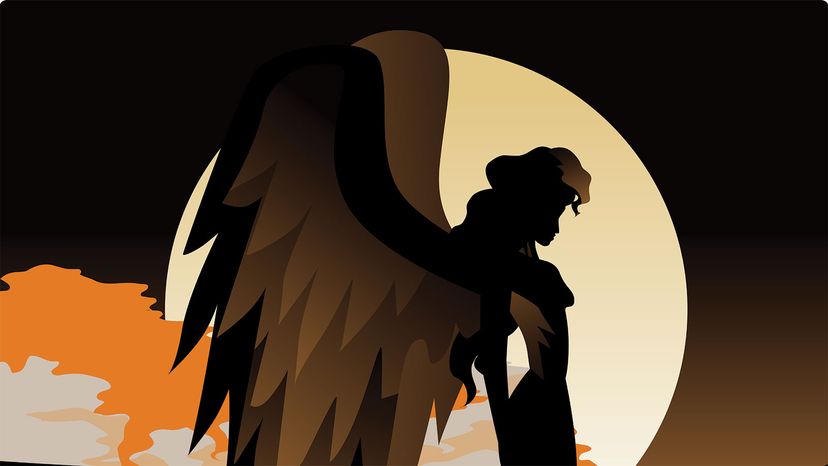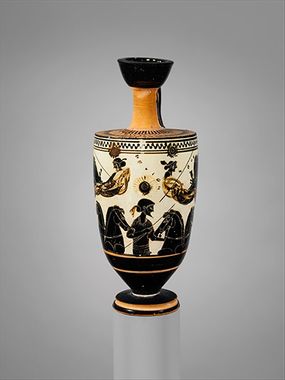
In Greek mythology, the goddess Nyx was one of the oldest deities in the universe, born in the first moments of creation from the yawning abyss of Chaos. Nyx was the personification of night and was so ancient and powerful that even mighty Zeus was afraid to cross her.
We spoke with Daniel Turkeltaub, a classics professor at Santa Clara University, to learn more about the mist-shrouded figure of Nyx, the chariot-riding queen of night and mother of death, deceit and dreams.
Advertisem*nt
Contents
- A Primordial Female Force of Good and Evil
- Nyx Was a Charioteer of the Sky
- Even Zeus Knew Not to Mess With Nyx
A Primordial Female Force of Good and Evil
Nyx (whose name Turkeltaub says should be pronounced as "nooks") is one of the "primordial" gods — protogenoi in Greek — who were born of Chaos, the gaping void that existed before creation. According to Hesiod's "Theogony," an epic poem dating from the eighth century B.C.E., Nyx's sisters and brothers were Gaia (Earth), Tartarus (the Pit), Eros (Love) and Erebus (Darkness).
Through a "union in love" with her dark brother Erebus, Nyx gave birth to two "luminous" offspring, Aether (Divine Air) and Hemera (Day). Then things took a turn. In Hesiod's cosmology, Nyx next self-conceived a brood of baddies that included the Keres (spirits of Violent Death), Moros (Doom), Oizys (Misery), Apate (Deceit), Nemesis (Retribution) and the Moirai (the three "ruthless and avenging" Fates).
Advertisem*nt
Hesiod attached negative descriptors to Nyx like "deadly Night" and "evil Night," but the ancient goddess was also the mother of more positive offspring like Hypnos (Sleep), the Oneiroi (Dreams), Geras (Old Age), Thanatos (Peaceful Death) and Philotes, which could mean either Friendship or Sex. "It is a nocturnal activity," says Turkeltaub.
Nyx Was a Charioteer of the Sky

Few ancient images of Nyx survive, but a stunning one comes from a terracotta vase at the Metropolitan Museum of Art in New York dating from 500 B.C.E.
The painted scene shows the hero Heracles offering a sacrifice to Helios (the Sun) as it rises. On either side of Helios are Nyx and Hemera, the goddesses of night and day, who each ride horse-drawn chariots in opposite directions as dawn breaks.
Advertisem*nt
The ancient Greeks developed a sophisticated mythology to explain the unknown workings of the natural world, like the alternation of night and day.
"In Greek mythology, Nyx and her daughter Hemera share an abode at the end of the earth," says Turkeltaub. "When one leaves on her chariot, the other enters."
Here's how Hesiod describes it:
"Nyx (Night) and Hemera (Day) draw near and greet one another as they pass the great threshold of bronze. And while the one is about to go down into the house, the other one comes out the door. And the house never holds them both within; but always one is without the house passing over the earth, while the other stays at home and waits until the time for her journeying come."
In the vase painting, Nyx is swathed in gauzy robes, and there's a dark cloud or mist above her head. Hesiod describes her resting place in Tartarus as "the awful home of murky Night wrapped in dark clouds."
Advertisem*nt
Even Zeus Knew Not to Mess With Nyx
There aren't many "stories" associated with Nyx, says Turkeltaub, but the ancient Greek author Homer makes a passing reference in his epic poem, the "Iliad," that shows us the respect and even fear that Nyx commanded.
In this part of the "Iliad," the powerful goddess Hera hatched a plan to "lay in love" with Zeus, but she needed help from Hypnos, the god of Sleep and son of Nyx. If Hypnos would just lull Zeus into a deep slumber, Hera promised him thrones of gold.
Advertisem*nt
Hypnos wasn't having it, though. He said that he played the same trick for Hera once before when she wanted to meddle in the Trojan War, and it didn't go well. Zeus woke up angry and "beat the gods up and down his house" in search of Hypnos, writes Homer.
Hypnos thought he was finished "had not Nyx (Night) who has power over gods and men rescued me," writes Homer. "I reached her in my flight, and Zeus let be, though he was angry, in awe of doing anything to swift Nyx's displeasure."
In other words, Zeus knew better than to tick off Nyx.
"The other gods do not mess with Nyx," says Turkeltaub. "She has a power that precedes Zeus. Nyx is a looming ancestral mother figure with a primordial power that other gods respect and revere."
Now That's Cool
While no statues of Nyx survive, there may have been a temple dedicated to her in the Greek coastal city of Megara. Turkeltaub says that the ancient Greek geographer Pausanias described a "temple to Night" at the acropolis in Megara where Nyx was believed to prophesy the future.
Advertisem*nt
I'm an enthusiast with a profound understanding of Greek mythology, particularly the intricate details surrounding the goddess Nyx. My knowledge is deeply rooted in extensive research, scholarly works, and a passion for unraveling the mysteries of ancient myths. To lend credence to my expertise, I'll delve into the concepts discussed in the provided article.
Nyx: The Primordial Goddess of Night
Primordial Female Force of Good and Evil: Nyx, pronounced as "nooks," belongs to the protogenoi, the primordial gods born of Chaos before the creation of the universe. Hesiod's "Theogony" reveals Nyx's siblings, including Gaia, Tartarus, Eros, and Erebus. Nyx's offspring, through a union with her dark brother Erebus, encompass both positive and negative entities, such as Aether and Hemera (Day), as well as Keres (spirits of Violent Death), Moros (Doom), and others.
Charioteer of the Sky: Though few ancient images of Nyx exist, a notable depiction on a terracotta vase from 500 B.C.E. at the Metropolitan Museum of Art portrays her as a charioteer alongside Hemera, the goddess of Day, as they ride horse-drawn chariots in opposite directions. This imagery symbolizes the alternating cycles of night and day in Greek mythology. Nyx and Hemera share an abode at the edge of the earth, and when one departs, the other enters.
Zeus's Respect for Nyx: Nyx's prominence extends to the point that even mighty Zeus treads carefully around her. In Homer's "Iliad," Hera seeks the assistance of Hypnos, Nyx's son and the god of Sleep, to lull Zeus into a deep slumber. Despite Hera's promise of golden thrones, Hypnos refuses, recalling a previous incident where Zeus, angered by his meddling, sought retribution. Only Nyx's intervention spared Hypnos from Zeus's wrath, highlighting the goddess's unparalleled power and respect among the gods.
Cult and Temple: While no surviving statues of Nyx exist, ancient sources, including Pausanias, suggest the possibility of a temple dedicated to Nyx in the Greek city of Megara. This temple, located at the acropolis, was believed to be a place where Nyx prophesied the future, adding an enigmatic dimension to her character.
In essence, Nyx emerges as a captivating figure in Greek mythology, embodying the duality of primordial forces and commanding respect even from the mighty Olympian gods. The scarce narratives surrounding Nyx only enhance her mystique, making her a compelling subject for exploration within the vast tapestry of ancient Greek myths.